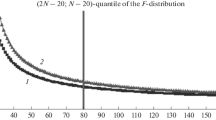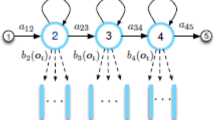Abstract
Sequential segmentation algorithms based on the AR model tend to produce false alarms or to omit the change for sequences that corresponds to the ARMA model. In this paper a new sequential segmentation algorithm based on the ARMA model is presented. The ARMA model is estimated over the relatively short sequence, which has called for the implementation of the estimation algorithm with appropriately initialized starting values. The proposed algorithm adopts the MGLR concept of the sliding reference and test windows, which allow the process of decision making to be separated from the evaluation of the discrimination function. This has enabled the new triangular decision rule to be proposed; this is based on the expected shape of the discrimination function at the time of the model change. Two possible discrimination functions have been suggested. One of them is optimal in the statistical sense; the other has the better asymptotic behavior. Natural speech signal segmentation is also discussed, and an appropriate pitch-synchronous signal prearrangement has been suggested. This not only enhances the segmentation algorithm but also increases its speed, as the time can be increased by a step equal to the pitch period. The segmentation algorithm is verified on test signals as well as on the natural speech signal. The experimental results also include a comparison of the sequential AR and ARMA model-based segmentation.
Similar content being viewed by others
References
R. Andre-Obrecht, On-line segmentation of speech signals without prior recognition, inDetection of Abrupt Changes in Signals and Dynamical Systems, eds. M. Basseville and A. Benveniste, Springer-Verlag, Berlin and New York, 1980.
U. Appel and A. V. Brandt, Adaptive sequential segmentation of piecewise stationary time series,Inform. Sci., vol. 29, 1983, pp. 27–56.
Detection of Abrupt Changes in Signals and Dynamical Systems, eds. M. Basseville and A. Beneviste, Springer-Verlag, Berlin and New York, 1986.
B. Friedlander, Lattice filters for adaptive processing,Proc. IEEE, vol. 70, no. 8, Aug. 1982, pp. 892–1017.
W. Hess,Pitch Determination of Speech Signals, Springer-Verlag, Berlin and New York, 1983.
I. Konvalinka and M. R. Mataušek, Simultaneous estimation of poles and zeros in speech analysis and ITIF — Iterative Inverse Filtering Algorithm,IEEE Trans. Acoust. Speech Signal Process., vol. ASSP-27, Oct. 1979, pp. 485–491.
I. Konvalinka and M. Milosavljević, Sequential detection of abrupt changes in the digital signals,Proc. XXX ETAN Conf., Herceg-Novi, June 1986 (in Serbian).
J. D. Markel and A. H. Gray, Jr.,Linear Prediction of Speech, Springer-Verlag, Berlin and New York, 1976.
M. R. Mataušek, S. S. Stanković, and D. V. Radović, Iterative inverse filtering approach to the estimation of frequencies of noisy sinusoids,IEEE Trans. Acoust. Speech Signal Process., vol. ASSP-31, Dec. 1983.
Y. Miyoshi, K. Yamato, R. Mizoguchi, M. Yanagida, and O. Kakusho, Analysis of speech signals of short pitch period by a sample-selective linear prediction,IEEE Trans. Acoust. Speech Signal Process., vol. ASSP-35, no. 9, pp. 1233–1239, September 1987.
I. V. Nikiforor, ed.,Sequential Detection of Abrupt Changes in Time Series Properties, “Nauka,” Moscow, 1983.
Z. M. Šarić, The abrupt change detection in the signals with the ARMA structure, Ph.D. dissertation, EE Dept., University of Belgrade, 1994 (in Serbian).
Z. Šarić and M. Milosavljević, Correlation approach in the detection of abrupt changes in the MGLR algorithm,Proc. XV Symp. on Inf. Technology, Sarajevo, March 1991, 251-1–254-8 (in Serbian).
Z. M. Šarić and S. R. Turajlić, Estimation and setting starting values in ARMA algorithms,Circuits Systems Signal Process., vol. 12, no. 1, 1993, pp. 85–103.
Y. Shiraki and M. Honda, LPC speech coding based on variable length segment quantization,IEEE Trans. Acoust. Speech Signal Process., vol. 36, no. 9, Sept. 1988, pp. 1437–1444.
T. Svedsen and F. K. Soong, On the automatic segmentation of speech signals,IC ASSP 1987, pp. 77–80.
E. Vidal and A. Marzal, A review and new approaches for automatic segmentation of speech signal,Proc. of EUSIPCO-90, Barcelona (Spain), Sept. 1990, vol. 1, pp. 43–54.
P. De Souza and P.J. Thomson, LPL distance measures and statistical tests with particular reference to the likelihood ratio,IEEE Trans. ASSP, vol. ASSP-30, no. 2, pp. 304–315, April 1982.
Author information
Authors and Affiliations
Additional information
Research supported in part by the Serbian Science Foundation, grant nos. 0403 and 1007.
Rights and permissions
About this article
Cite this article
Turajlić, S.R., Šarić, Z.M. Sequential speech segmentation based on the spectral ARMA transition measure. Circuits Systems and Signal Process 15, 71–92 (1996). https://doi.org/10.1007/BF01187694
Received:
Accepted:
Issue Date:
DOI: https://doi.org/10.1007/BF01187694




